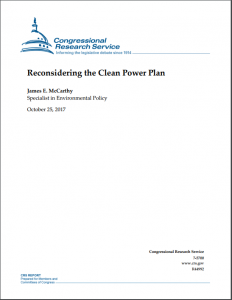Full Title: Reconsidering the Clean Power Plan
Author(s): James E. McCarthy
Publisher(s): Congressional Research Service
Publication Date: October 1, 2017
Full Text: Download Resource
Description (excerpt):
On October 10, 2017, the U.S. Environmental Protection Agency (EPA) proposed to repeal the Clean Power Plan (CPP), an Obama Administration rule that would limit carbon dioxide (CO2) emissions from existing fossil-fuel-fired power plants. Because power plant CO2 emissions account for about 30% of total U.S. anthropogenic emissions of greenhouse gases (GHGs), the CPP has been seen as the most important U.S. regulation addressing climate change.
The CPP has not gone into effect: In February 2016, the U.S. Supreme Court stayed its implementation pending the completion of judicial review. Even had it not been stayed, the rule’s limits on CO2 emissions were not scheduled to begin taking effect until 2022. The Court’s action delayed various planning requirements that would have determined how states intended to structure compliance with the rule’s overall objectives.
Unlike the suspension of the CPP that is currently in place due to the Supreme Court’s stay, repealing a promulgated rule requires that the promulgating agency go through the same steps as the original rulemaking, a process governed in this case by Section 307(d) of the Clean Air Act. The first step in the repeal process is a 60-day comment period following publication of the proposed repeal in the Federal Register. Ultimately, EPA will need to address all significant comments and criticisms that it receives during the public comment period when it promulgates a final decision on the proposed repeal. The agency’s decision could then be subject to judicial review
